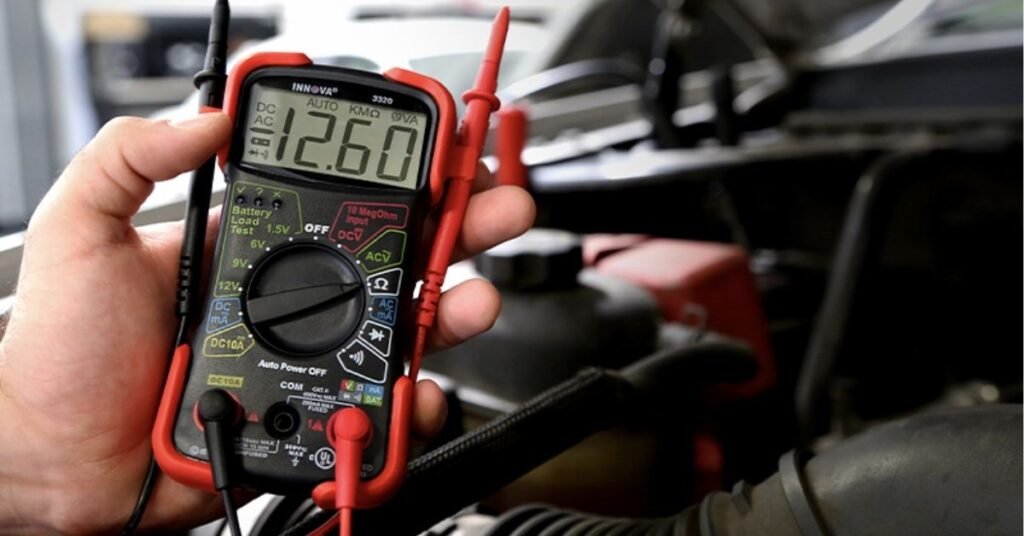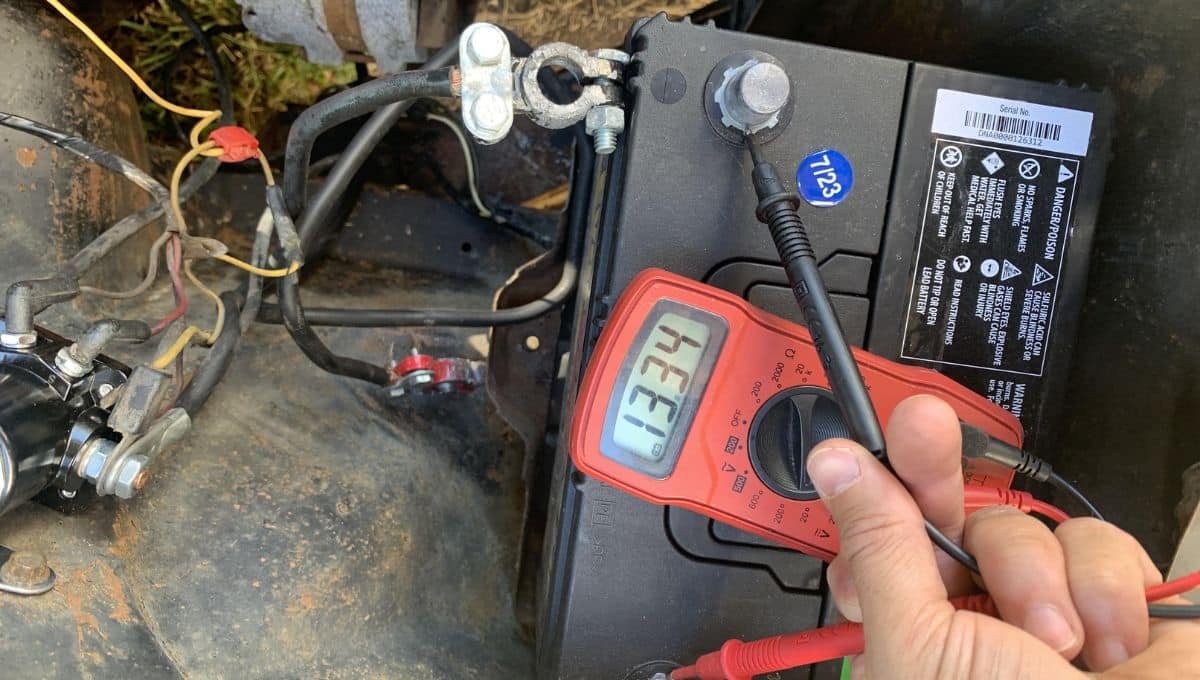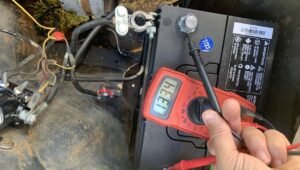When a Car Battery Tests Good but Still Fails – A Common Reason!
I once had a car battery that tested fine at the shop but failed me in freezing weather. It turned out there was internal degradation not picked up in standard tests.
Regular maintenance and checking other components, like the alternator and terminals, could have prevented this frustrating experience.
Understanding the Basics: How Car Batteries Work
The Role of a Car Battery in Your Vehicle:
A car battery is often considered the heart of your vehicle’s electrical system. It’s not just responsible for starting the engine but also powers all the electrical components in your car, from the lights to the radio.
Essentially, without a properly functioning battery, your vehicle would be little more than a hunk of metal.
The battery supplies the necessary electrical current to start the engine, and once the engine is running, the alternator takes over, keeping the battery charged and the electrical systems powered. It’s a critical component, and its health directly influences the overall performance of your vehicle.
Common Signs of a Failing Car Battery:
While modern vehicles have become more sophisticated, the signs of a failing battery have remained relatively consistent. Dimming headlights, slow cranking when starting the engine, and an illuminated battery warning light on the dashboard are some of the most common indicators.
Additionally, if you notice that your car’s electrical components are not functioning as efficiently as they should—such as flickering dashboard lights or malfunctioning power windows—these could be tell-tale signs that your battery is on its last legs.
A sulfuric smell, often compared to rotten eggs, can also indicate a leaking battery, which not only signifies imminent failure but also poses a safety risk.
Why a Good Battery Can Still Cause Problems:
It’s perplexing to discover that even when a battery tests good, issues still arise. A battery might test as “good” under standard conditions but fail under real-world stress.
This discrepancy can be attributed to several factors, including internal short circuits, intermittent connections, or degradation of the battery’s internal components that aren’t detected in basic tests.
A “good” battery on paper may not perform well when required to deliver a high current load, such as during extreme weather conditions or when starting an engine after the car has been sitting idle for a long time.
This is why understanding the limitations of battery testing is crucial to diagnosing the actual cause of battery-related issues.
The Diagnostic Process: Testing a Car Battery

How Mechanics Test Car Batteries for Health:
Testing a car battery involves more than just checking if it holds a charge. Mechanics employ various tests to determine the battery’s overall health.
The most common method is the voltage test, where a multimeter measures the battery’s voltage. A healthy battery typically reads around 12.6 volts or more when fully charged.
However, voltage alone doesn’t tell the whole story. Mechanics also perform a load test, which assesses the battery’s ability to maintain a voltage level under a simulated load, similar to the strain the battery would experience when starting the engine.
If the voltage drops significantly during this test, it indicates that the battery might not be reliable under real-world conditions.
The Difference Between a Voltage Test and a Load Test:
The voltage test and load test serve different purposes, each offering insight into the battery’s condition. A voltage test is a quick and straightforward way to determine if the battery has enough charge.
However, it doesn’t account for how the battery performs under stress. That’s where the load test comes in. During a load test, a controlled load is applied to the battery while monitoring how the voltage drops.
This test is more reflective of the battery’s actual performance, as it mimics the demands of starting an engine.
A battery that passes a voltage test but fails a load test may appear healthy in a no-load situation but is likely to struggle under real operating conditions.
Common Misconceptions About Battery Testing Results:
Battery testing results can be misleading if not properly understood. One common misconception is that a battery with a good voltage reading is necessarily in good condition.
In reality, a battery can have an acceptable voltage reading and still be unable to deliver the necessary power when needed. Another misconception is that battery testing is infallible.
While tests are useful diagnostic tools, they can’t always detect subtle internal issues like sulfation or minor cell damage, which can lead to failure under stress.
Moreover, environmental factors and the vehicle’s electrical system can influence testing results, leading to false positives or negatives.
read also: Why the Battery Light Stays On When Ignition Is Off in Silverado – Here’s Why!
The Hidden Culprits: Issues Beyond the Battery
Corroded or Loose Battery Terminals: The Silent Problem
Battery terminals are the gateway for electricity to flow from the battery to the rest of the vehicle. Corrosion or loose connections at these terminals can severely impair the battery’s ability to deliver power.
Corrosion, often seen as a white or bluish powder on the terminals, increases resistance in the connection, causing the battery to work harder to deliver the same amount of power.
This not only affects the battery’s performance but can also lead to premature failure. Loose terminals, on the other hand, can cause intermittent electrical connections, leading to erratic vehicle behavior, such as difficulty starting or flickering dashboard lights. Regular inspection and cleaning of the battery terminals can prevent these issues from escalating.
Faulty Alternators: How They Can Mimic Battery Issues
The alternator plays a crucial role in keeping the battery charged and the vehicle’s electrical system running. A faulty alternator can easily be mistaken for a battery problem, as the symptoms are strikingly similar—dimming lights, difficulty starting, and even a dead battery.
If the alternator isn’t working correctly, it won’t recharge the battery while the engine is running, leading to a gradual depletion of the battery’s charge. Over time, this can cause the battery to fail prematurely.
It’s essential to check the alternator’s performance if you’re experiencing battery-related issues, as replacing the battery alone won’t solve the underlying problem.
Parasitic Drains: The Underlying Cause of Battery Drain
Parasitic drains occur when certain components in the vehicle continue to draw power from the battery even when the car is turned off.
While some power draw is normal, such as the clock or security system, excessive drain can quickly deplete the battery. Common culprits include faulty wiring, malfunctioning switches, or aftermarket accessories that aren’t properly installed.
Identifying and rectifying these parasitic drains is critical because even a new, fully charged battery can be rendered useless if it’s constantly being drained by an unnoticed electrical issue. This problem is particularly insidious as it often goes unnoticed until the battery fails completely.
Environmental Factors: The Impact of Weather on Battery Performance

The Effect of Extreme Cold and Heat on Car Batteries:
Temperature extremes can have a significant impact on a car battery’s performance and longevity. Cold weather, in particular, thickens the engine oil, making it harder for the battery to start the engine.
At the same time, the battery’s chemical reactions slow down in cold temperatures, reducing its ability to deliver a strong current.
In contrast, extreme heat accelerates the battery’s chemical reactions, which might seem beneficial at first, but it also increases the rate of evaporation of the battery’s electrolyte, leading to a shortened lifespan. Both scenarios can cause a battery to fail unexpectedly, even if it tested well under normal conditions.
How Humidity and Moisture Can Lead to Battery Failure:
Humidity and moisture can have a detrimental effect on a car battery, particularly if the battery terminals or case are exposed to prolonged dampness. Moisture can lead to corrosion of the terminals, increasing electrical resistance and reducing the battery’s efficiency.
In some cases, moisture can seep into the battery itself, contaminating the electrolyte and leading to internal short circuits.
This is especially problematic in regions with high humidity or for vehicles that are frequently exposed to wet conditions. Ensuring that your battery is properly sealed and that the terminals are clean and dry can help mitigate these risks.
Seasonal Battery Maintenance Tips to Prevent Unexpected Failures:
Seasonal changes call for different battery maintenance strategies. In colder months, it’s essential to ensure that your battery is fully charged and that the terminals are free from corrosion.
Using a battery warmer can also help maintain the battery’s temperature and performance during the winter. In hotter climates, keeping the battery cool is key—parking in the shade and ensuring adequate ventilation under the hood can prevent the battery from overheating.
Regularly checking the battery’s electrolyte level and topping it up if necessary can also extend the battery’s life. These preventive measures can significantly reduce the risk of a sudden battery failure.
read also: How a Car Battery Can Affect Your Immobilizer System – Fix Issues Fast!
Electrical System Malfunctions: When the Problem Isn’t the Battery
Wiring Issues: How Frayed Wires Can Disrupt Battery Function
The integrity of a vehicle’s wiring is crucial for the proper functioning of its electrical system, including the battery. Frayed or damaged wires can cause a myriad of problems, from intermittent electrical faults to complete system failures.
When wires are compromised, the electrical signals that control various components, including the charging system, can be disrupted. This can lead to situations where the battery isn’t charging correctly, despite the alternator functioning properly.
In some cases, frayed wires can even cause short circuits, which can drain the battery rapidly or cause other electrical components to malfunction. Regular inspection of the vehicle’s wiring, especially in older vehicles, is essential for maintaining a reliable electrical system.
The Role of Fuses and Relays in Maintaining Battery Health:
Fuses and relays are the unsung heroes of your car’s electrical system. They protect your vehicle’s circuits from overloads and ensure that electrical components function properly.
A blown fuse or a faulty relay can disrupt the flow of electricity, leading to issues that mimic battery problems. For instance, if a fuse related to the charging system blows, the battery may not receive the charge it needs from the alternator, leading to a gradual drain.
Similarly, a malfunctioning relay can cause certain components to draw power continuously, even when the vehicle is off, leading to a dead battery. Understanding and checking the condition of your fuses and relays can prevent these issues.
How Ignition System Problems Can Affect Battery Performance:
The ignition system is critical for starting your vehicle, and any faults within this system can have a direct impact on the battery. A malfunctioning ignition switch or faulty spark plugs can cause the engine to crank excessively before starting, placing undue strain on the battery.
Over time, this extra load can deplete the battery’s charge, reducing its lifespan and reliability. In some cases, ignition system problems can also prevent the engine from starting altogether, leading to a mistaken diagnosis of a dead battery.
Addressing ignition system issues promptly can help preserve your battery’s health and ensure reliable vehicle performance.
Preventive Measures: Ensuring Your Battery Stays Reliable

Regular Battery Maintenance Practices:
Maintaining your car battery is not just about ensuring it holds a charge—it’s about prolonging its life and performance.
Regular maintenance practices include cleaning the terminals to prevent corrosion, checking the battery’s charge with a multimeter, and inspecting the battery case for any signs of damage or leakage.
Additionally, ensuring that the battery is securely mounted can prevent vibrations that may lead to internal damage.
For vehicles that are not driven frequently, using a trickle charger can keep the battery at an optimal charge level, preventing deep discharge and sulfation, which are common causes of battery failure.
The Importance of Checking Your Vehicle’s Electrical System:
Your vehicle’s electrical system is a complex network that must function harmoniously for the battery to remain healthy. Regularly checking components such as the alternator, starter, and voltage regulator can identify potential issues before they lead to battery failure.
An electrical system check should also include inspecting the wiring for signs of wear or damage and ensuring that all connections are secure. In modern vehicles, where electrical demands are higher than ever, keeping the electrical system in top condition is essential for battery longevity.
When to Replace Your Battery: Signs It’s Time for a New One
No battery lasts forever, and knowing when to replace yours is crucial to avoiding unexpected breakdowns. If your battery is more than three years old, it’s wise to start monitoring it closely for signs of wear.
Difficulty starting the engine, frequent need for jump-starts, or visible signs of corrosion are all indicators that your battery may be nearing the end of its life.
Additionally, if your battery fails a load test or if its voltage consistently drops below 12 volts, it’s time to consider a replacement. Proactively replacing a failing battery can save you from the inconvenience of being stranded and ensure your vehicle remains reliable.
read also: Car Alarm Goes Off When Charging Battery – Common Causes!
FAQ’s
1. Why might a car battery test as good but still fail?
A battery may test good under normal conditions but fail under real-world stress due to internal short circuits, intermittent connections, or degradation that basic tests don’t detect.
2. What is the difference between a voltage test and a load test for a car battery?
A voltage test measures the battery’s charge level, while a load test assesses its performance under simulated stress, such as starting the engine. A battery may pass a voltage test but fail a load test if it can’t maintain voltage under load.
3. What can cause a car battery to fail besides the battery itself?
Common culprits include corroded or loose battery terminals, a faulty alternator, parasitic drains, frayed wiring, and issues with fuses or relays.
4. How do extreme temperatures affect car battery performance?
Cold weather can reduce the battery’s ability to deliver a strong current, while heat accelerates electrolyte evaporation, shortening the battery’s lifespan.
5. What maintenance practices can help extend the life of a car battery?
Regular maintenance includes cleaning battery terminals, checking the charge level, inspecting the battery case for damage, ensuring secure mounting, and using a trickle charger for infrequent use.
Conclusion:
Even if a car battery tests good, it can still fail due to internal issues, stress conditions, or other factors like corrosion, faulty alternators, or parasitic drains. Proper battery maintenance, including regular inspections and addressing potential problems with the electrical system, is essential for ensuring reliable performance and avoiding unexpected failures.
Read Also:
Does Leaving USB Plugged in Car Drain Battery – Here’s the Answer!
Can I Run 2 Amps Off a Single Car Battery – The Truth Revealed!
Can a Bad Battery Cause O2 Sensor Code – Find Out Now!
Can a Bad Battery Cause Stabilitrak Problems – Find Out Now!














Post Comment